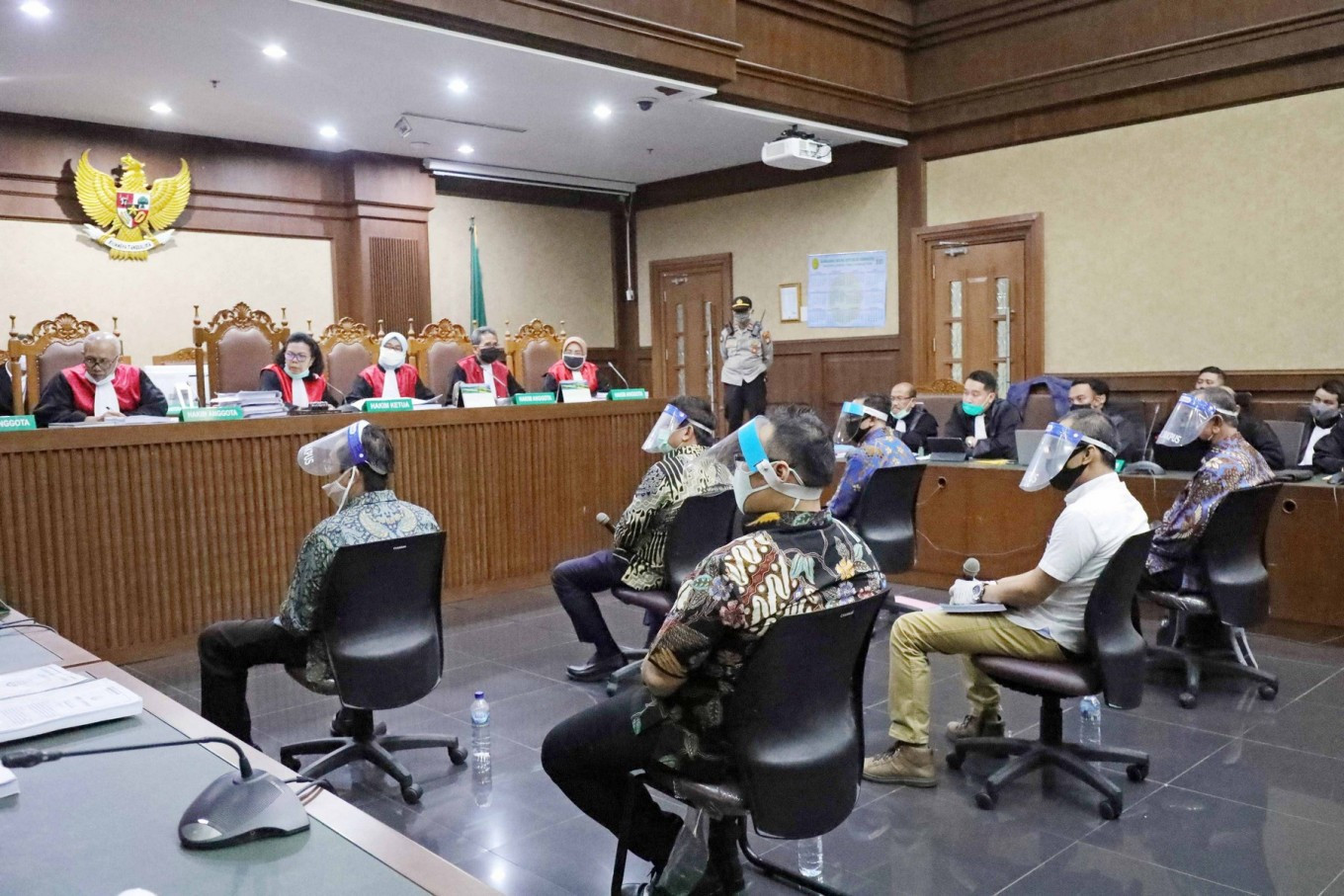News
AGO names Budget Director General suspect in Jiwasraya scandal
Tenggara Strategics February 18, 2025 Defendants wear face shields and masks during a hearing in the PT Asuransi Jiwasraya case at the Jakarta Corruption Court. (JP/Dhoni Setiawan)
Defendants wear face shields and masks during a hearing in the PT Asuransi Jiwasraya case at the Jakarta Corruption Court. (JP/Dhoni Setiawan)
Despite its scheduled dissolution in 2025, new revelations have emerged regarding the massive graft case at state-owned insurer PT Jiwasraya. The case, which led to state losses of Rp 16.8 trillion (US$1.06 billion), is among the largest financial scandals in Indonesia’s history. The Attorney General’s Office (AGO) recently named Isa Rachmatarwata, the Finance Ministry’s budget director general, as a suspect in the case. According to the AGO, Isa allegedly played a key role in approving Jiwasraya’s ill-fated JS Saving Plan in 2009 despite knowing that the company was already financially insolvent at the time.
The AGO’s director of investigation and special crimes Abdul Qohar emphasized that Isa should have been well aware of Jiwasraya’s dire financial situation given his position at the time as the former head of the Insurance Bureau at the Capital Market and Financial Institutions Supervisory Agency (Bapepam-LK). Investigators reviewed reports from Bapepam and found evidence that, as of Dec. 31, 2008, Jiwasraya had a significant shortfall in its reserved funding for policyholder liabilities, totaling approximately Rp 5.7 trillion.
Under normal circumstances, a company with such a substantial funding gap should not have been permitted to introduce a new insurance product. However, the JS Saving Plan was approved despite clear red flags. Not only was Jiwasraya in financial distress, but the product itself was inherently problematic. The JS Saving Plan was an investment-linked insurance product that promised unusually high returns, with interest rates ranging between 9 and 13 percent. These figures were significantly higher than Bank Indonesia’s benchmark rates at the time, which were only between 7.5 and 8.75 percent.
The risks associated with the JS Saving Plan became evident over time. By 2018, Jiwasraya had accumulated a massive financial burden, ultimately defaulting on Rp 802 billion worth of matured policies. The product, which began sales in 2012, had an average maturity period of just five years, making it a short-term investment despite its high promised returns. Its structure relied on Jiwasraya reinvesting funds collected from policyholders in order to generate enough income to meet payout obligations. However, due to the short maturity period and the exorbitant interest rates, Jiwasraya was never in a position to sustainably fulfill these commitments.
Additionally, the JS Saving Plan included a feature that allowed policyholders to withdraw their funds before maturity, further straining Jiwasraya’s liquidity. This created a precarious financial cycle where the company continuously needed new premium payments to cover prior obligations, an unsustainable practice that eventually collapsed under its own weight.
According to details from the AGO’s investigation, the JS Saving Plan was developed and implemented under the leadership of Jiwasraya’s former top executives, including former president director Hendrisman Rahim, former finance director Hary Prasetyo, and former Investment and Finance Division head Syahmirwan. All three have since been convicted for their roles in the scandal.
Between 2014 and 2017, the JS Saving Plan attracted approximately Rp 47.8 trillion in premiums. However, instead of being managed responsibly, these funds were funneled into risky investments under the direction of the aforementioned executives. A significant portion of the funds was invested in stocks such as IIKP, SMRU, TRAM, LCGP, MYRX, SMBR, BJBR and PPRO, many of which were underperforming. This mismanagement led to mounting losses, further exacerbating Jiwasraya’s already fragile financial state.
As of the end of 2024, Jiwasraya had managed to pay only Rp 132 billion toward its liabilities for retirees, while its total payment obligations amounted to Rp 486 billion. With its complete dissolution looming in 2025, the company faces major challenges in meeting these obligations. Since most of Jiwasraya’s assets are currently frozen and it can no longer operate as a functioning insurance provider, its ability to generate revenue through normal business activities has been entirely cut off, severely limiting its options for covering outstanding liabilities.
Looking ahead, Jiwasraya is expected to liquidate assets from its employer pension fund (DPPK) to help settle its remaining debts. Reports indicate that the company has approximately Rp 654.5 billion in DPPK assets, including Rp 149.1 billion in net liquid assets. This liquidation may provide some relief, but it is still uncertain whether it will be enough to fully cover the company’s obligations. Additionally, another potential source of funds lies in the seized assets from the Jiwasraya fraud case. If ongoing legal proceedings result in a favorable outcome, these assets, estimated to be worth up to Rp 257 billion, could be used to further reduce the company’s outstanding liabilities.
What we've heard
Several government sources indicate that the designation of Isa as a suspect in the Jiwasraya corruption case is closely tied to political maneuvering ahead of the launch of the BPI Danantara investment agency. One source claimed that SOEs Minister Erick Thohir was allegedly “locking in” President Prabowo Subianto using the Jiwasraya case in matters related to the establishment of Danantara.

